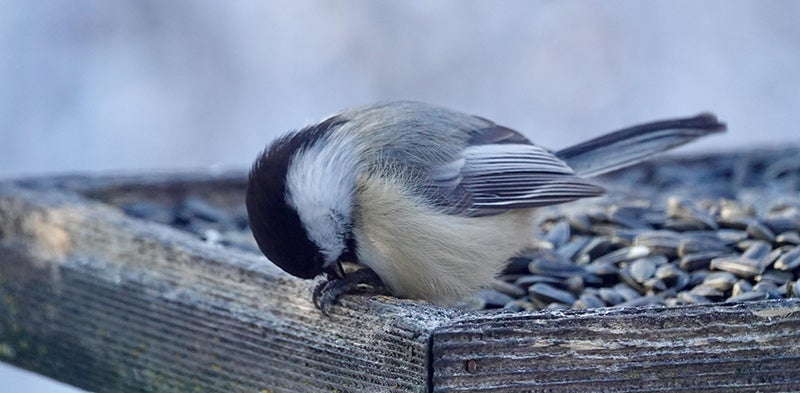Al Batt: Owls’ ear tufts do have purpose, though exact purpose is unknown
Published 9:00 am Saturday, March 3, 2018

- A chickadee opening a sunflower seed or saying grace before eating. Al Batt/Albert Lea Tribune
Al Batt of Hartland is a member of the Albert Lea Audubon Society. Email him at SnoEowl@aol.com.
My neighbor Crandall stops by.
“How are you doing?” I ask.
“Everything is nearly copacetic. I had some twice-baked bread covered in goober paste this morning. That’s a good start. I did nothing yesterday. Today I’m going to try to finish what I began yesterday. I work only to avoid daytime television. I talked to my favorite weatherman, Grunion Sleet, and he made me realize that meteorologists are really experts on meteors, not weather. I was looking for something else in the attic and I found our old Scrabble game. I find everything while looking for something else. That game was fun. Remember how we’d play until someone got angry and then we’d throw the tiles at one another? Then your mother would come in and tell us to stop it because it was all fun and games until somebody loses an ‘i.’”
Nature by the yard
I went outside without the cellphone. In today’s world, that could lead to a great adventure filled with thrills and tribulations. Such derring-do makes me an epic explorer. I wanted to see and hear things that weren’t on a small screen. Looking at and listening to birds are my default settings. Just as birds exploit a niche in order to survive, I have found my niche in order to live better.
I saw passerines. About half of all bird species are passerines. A passerine is a bird of the order Passeriformes, which have feet specialized for perching. The order includes our songbirds. Goldfinches were singing. A cardinal was doing his “What cheer, what, what, what.“ A black-capped chickadee flew into the feeder, grabbed a sunflower seed and left. The tiny bird traveled on rapid wingbeats, about 27 of them per second. I heard another chickadee call, sounding closer than he was. A feathered ventriloquist throwing his voice. A much larger bird moved away quickly. A wild turkey can run up to 25 mph and make short flights up to 55 mph.
In “Ferris Bueller’s Day Off,” Ferris Bueller said, “Life moves pretty fast. If you don’t stop and look around once in awhile, you could miss it.”
That certainly applies to appreciating the charms of nature.
Q&A
“Why do great horned owls have ear tufts?” The feathered tufts, called plumicorns, have a purpose, but the exact purpose is unknown. Ear tufts may be for camouflage. They help break up the outline of an owl and make it look more like a broken branch or another natural feature. Prominent ear tufts may signal good health, strength and energy that make an owl a desirable mate. They might be used for communication as a part of courtship displays, threat postures or to express emotions.
“Where did the phrase ‘for the birds’ come from?” The phrase is typically used to mean that something is trivial, meaningless or useless. It’s believed to be U.S. Army slang that originated during World War II. The phrase might derive from the habit of some birds to peck at horse droppings in search of undigested seeds. That horse exhaust is for the birds.
“My car is a target for birds. Is it the color of the car that attracts them to use it as a restroom?” It’s likely the location of your car that causes it to be dropped on by droppings. A study conducted by online retailer Halfords, revealed red vehicles made up 18 percent of cars marked by birds, while blue followed in second place at 14 percent. Green vehicles got away the cleanest, making up just 1 percent of those hit.
“What was the first bird book?” The first bird book, “Avium Praecipuarum,” was published in 1544 and authored by William Turner, the father of British ornithology. In the book, Turner included his own bird observations plus the natural history writings of Aristotle and Pliny.
“What bird runs the fastest?” Usain Bolt hit 27.8 miles per hour in a sprint. That’s the best a human has done. An ostrich tops that easily. It hits a top speed of 43 mph and can trot at 31 mph for miles. An emu hits 30 mph. A roadrunner’s top speed is 26 mph, which is no match for a coyote’s 43 mph. A wild turkey can hit 25 mph.
“What is the biggest bird seen in Minnesota?” The whooping crane, occasionally seen in the Gopher State, is the tallest. The trumpeter swan is the heaviest, edging out the wild turkey for that honor. The American white pelican has the longest wingspan.
Wade and Sharon Olson of New Ulm asked if orioles reuse a nest. Baltimore orioles don’t reuse their old nests, but females sometimes pull apart a previous year’s nest for materials.
Thanks for stopping by
“Nothing is a waste of time if you use the experience wisely.“ — Auguste Rodin
“There is no subject so old that something new cannot be said about it.” — Fyodor Dostoyevsky
Do good.



